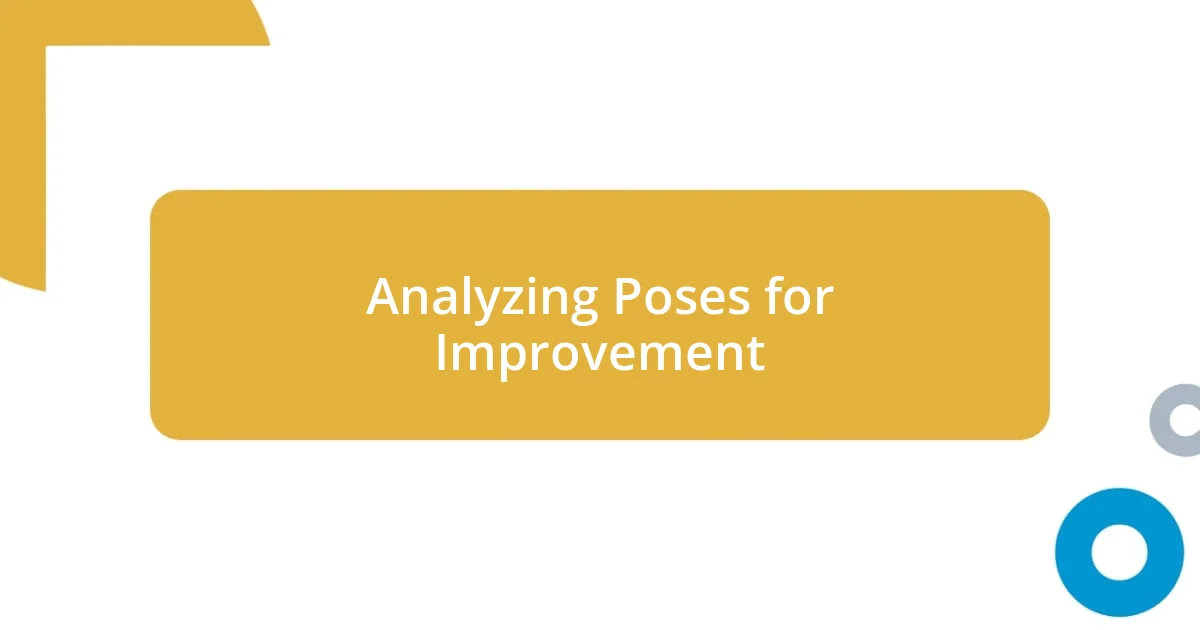Key takeaways:
- Posing should blend technical guidance with emotional connection, helping clients feel authentic and confident in front of the camera.
- Different types of poses, such as classic, candid, and action poses, serve specific purposes that can enhance storytelling and capture genuine interactions.
- Effective use of props, backgrounds, and constructive feedback during shoots can transform moments, resulting in unique and memorable photographs.

Understanding Client Posing Basics
When I first started working with clients at events, I quickly realized that posing is not just about positioning; it’s about capturing the essence of who they are. I remember one particular event where a client felt stiff and uncertain. I asked her to think about something that made her genuinely happy, and suddenly, her posture softened, creating a much more natural and engaging image.
Understanding client posing basics involves not only the technical aspects, like angles and light but also the emotional connection that clients have with themselves. I often find myself asking clients to visualize their ideal self or recall a moment where they felt confident. This approach not only elevates the pose but also creates a more authentic vibe in the photos. Have you ever noticed how a genuine smile can totally change the energy of a shot?
Another important aspect of posing is the balance between guidance and freedom. While it’s essential to provide direction, I find that allowing clients some creative freedom can lead to the best results. I recall encouraging a client to play around with different poses during a shoot, and the unguarded moments we captured were pure gold. It showed me how vital it is to strike that balance, making the experience enjoyable while achieving stunning images.

Importance of Posing at Events
Posing at events holds a significant importance that goes beyond mere aesthetics. I’ve noticed that a well-composed pose can evoke strong emotions and tell a story about the individual. During one wedding shoot, I guided the couple to pose in a way that reflected their playful bond. The result was a series of images filled with laughter and joy, capturing the essence of their relationship in a way that posed shots rarely do.
Additionally, the way clients are posed can influence how they feel in front of the camera. I once worked with a shy client who struggled to find her confidence. By shifting her pose and encouraging her to lean into her strength, she transformed into a radiant version of herself. This experience highlighted how effective posing can help clients rediscover their inner charm, leading to memorable photographs that resonate deeply with them.
Ultimately, posing is essential in creating a comfortable atmosphere that encourages clients to express themselves. At a recent corporate event, I adapted the poses to reflect the unique personalities of each attendee. One client, who was typically reserved, later shared that she felt empowered and appreciated through our session. This reinforced the idea that posing at events isn’t merely about appearances; it’s about fostering connections that resonate long after the camera clicks.
| Aspect | Importance |
|---|---|
| Emotional Connection | Brings out authentic feelings, enhancing the photo storytelling. |
| Confidence Boost | A well-guided pose can help clients feel more comfortable and confident in front of the camera. |
| Personal Expression | Encourages clients to express their individuality, making each photo unique. |

Types of Poses for Events
When I think about the various types of poses I often use at events, I realize they can significantly shape the final images. For instance, I frequently rely on classic posed shots that bring a touch of elegance, especially during formal gatherings. Then there are candid poses, where I let the clients interact naturally, fostering spontaneous moments that can result in authentic emotion. In one corporate event, I encouraged a team to engage with each other, and the genuine camaraderie we captured was electrifying.
Here’s a quick rundown of the types of poses you might consider for events:
- Classic Poses: Formal, traditional stances that highlight elegance and professionalism.
- Candid Poses: Natural interactions among clients that capture genuine smiles and expressions.
- Action Poses: These involve movement, such as dancing or laughing, creating dynamic and lively images.
- Environmental Poses: Positioning clients within their surroundings to tell a story about the event and its context.
- Group Poses: Arranging multiple people in a way that emphasizes relationships while maintaining balance and symmetry.
Each type of pose serves a specific purpose, and my experiences have taught me which ones resonate best in different settings. In one case, an outdoor wedding at sunset allowed for stunning environmental poses that emphasized the beauty around the couple, enhancing the romantic vibe. It’s fascinating how these different styles can change the narrative of the event and how clients perceive the moments captured.

Tips for Directing Clients
Directing clients during a shoot requires a personal touch. I remember one family event where the kids were restless. Instead of forcing them into a stiff pose, I suggested they jump and play. The result? Genuine laughter and expressions that told a much more vibrant story than any posed picture could. Isn’t it fascinating how movement can transform a moment into something truly memorable?
Another tip I’ve learned is to establish a rapport with clients before posing them. One time, before a corporate shoot, I shared a few jokes that instantly lightened the atmosphere. When we transitioned to posing, my clients felt relaxed, leading to images that conveyed their professionalism with a genuine warmth. It’s a reminder that connection is key; how often do we overlook that simple truth?
Lastly, don’t hesitate to experiment with angles and perspectives. During a recent outdoor gathering, I climbed a small wall to capture a bird’s-eye view of the group. The different perspective not only highlighted their interactions but also gave a fresh twist to the traditional group shot. Have you ever considered how changing your viewpoint could elevate your photography? It’s an exhilarating feeling to discover new ways to celebrate each moment.

Creating Natural Interaction Between Clients
Creating natural interactions between clients is a compelling aspect of event photography that enhances the storytelling of each moment captured. I often encourage clients to engage in light-hearted activities, like sharing fun memories or even a playful mini-game. Once, at a milestone birthday party, I facilitated a simple guessing game about the birthday person. The laughter and spontaneity that emerged not only produced candid shots filled with genuine smiles but also highlighted the warmth of their relationships.
I also find that asking open-ended questions can ignite genuine conversations amongst clients. During a recent networking event, I posed a question about their favorite travel experiences while photographing them. As they exchanged stories, their natural rapport shone through, resulting in delightful candids that depicted authenticity rather than mere posed smiles. Have you ever noticed how a simple question can break the ice and make people feel more at ease? It’s those moments of connection that really elevate the final images.
Creating a relaxed environment is crucial, too. When clients feel comfortable, they tend to drop their defenses and interact more freely. I remember one formal gala where I encouraged the clients to toast with their drinks. The resulting images were filled with genuine joy, capturing the essence of celebration. It’s fascinating how the right prompts can change the dynamics of a shoot, paving the way for memorable interactions that tell a richer story through photography.

Using Props and Backgrounds Effectively
Using props and backgrounds effectively can truly elevate the storytelling aspect of event photography. I vividly recall a wedding where the couple had brought along vintage suitcases as part of their decor. Instead of having them stand stiffly beside each other, I placed the suitcases between them and asked them to interact with the props—opening them up, pretending to search for items. Those playful moments not only produced unique shots but also reflected the couple’s personality and their love for travel. Isn’t it amazing how the right prop can spark creativity and evoke emotion?
Meanwhile, selecting backgrounds that resonate with the event adds depth to the images captured. At a community fair, I noticed a beautiful mural that encapsulated the spirit of the festival. I invited the attendees to gather in front of it, encouraging them to strike fun poses. The vibrant colors and lively scenery not only captured their joy but also communicated the celebration in a powerful way. Have you ever thought about how a simple backdrop can change the overall mood of a shoot?
Ultimately, the interplay between props, backgrounds, and the subjects can yield striking results. During a corporate retreat, I used a simple whiteboard as both a prop and a backdrop for a brainstorming session. I encouraged the team to jot down their ideas while I captured their enthusiasm in real-time. The images were not just visually appealing—they were a testament to collaboration and innovation. In my experience, thoughtful consideration of these elements transforms ordinary moments into extraordinary stories.

Analyzing Poses for Improvement
Evaluating poses for improvement often requires a keen eye and a willingness to experiment. I remember a corporate event where I felt the initial poses were too stiff and uninviting. So, I decided to ask the team to switch places and adopt a more casual posture, leaning against the table and engaging with one another naturally. The shift not only brought a new energy to the images but also reflected their camaraderie. Have you ever tried changing the positioning of your subjects mid-shoot? It can yield surprising results.
I also find that analyzing the angles from which I shoot can drastically influence the final outcome. At a recent awards ceremony, I was positioned too far away from the stage. It was only when I moved closer and captured the reactions of the attendees that I truly started to feel the excitement and anticipation of the event. Those close-up shots, filled with raw emotion, told a story that distant framing could never achieve. Isn’t it fascinating how shifting just a few feet can make such a difference in storytelling?
In my experience, providing clients with constructive feedback during the session can spark quick improvements. During a family reunion shoot, I noticed one of the kids standing with his arms crossed, looking disengaged. I gently suggested he incorporate his favorite toy into the pose. The moment he held it up and started goofing around, the whole family burst into laughter, resulting in some of my favorite shots filled with joy and authenticity. How often do we underestimate the power of a simple suggestion to transform a moment? It’s those small changes that lead to the most memorable images.














